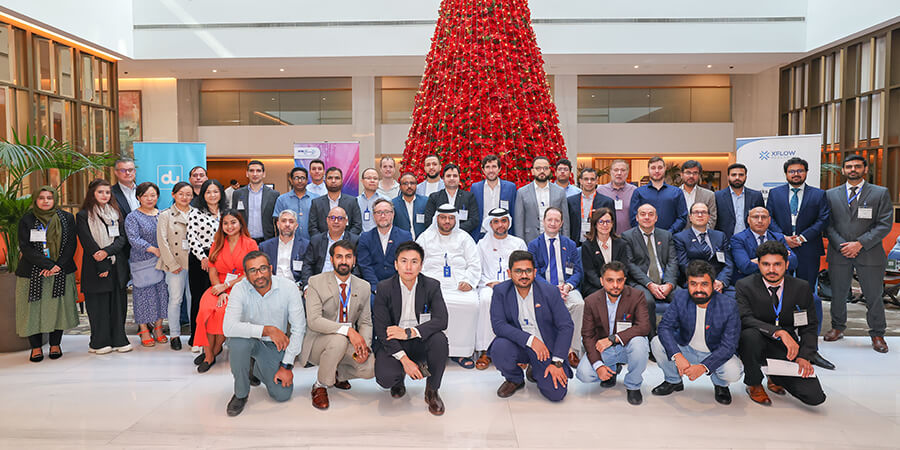In cooperation with xFlow Research, du hosted the event entitled ‘Standardization Day - ETSI Meets UAE’ which took place for the first time in the MENA region, on December 4, 2023, at the Grand Cosmopolitan Hotel, Dubai.
To foster technology information exchange between the UAE and ETSI, the concept for this event was suggested by the CEO of xFlow Research, Ashok Malani. As part of the organizers’ team, Fathi Abdeldayem, Technology Standardization, R&D and Evolving Technologies, du has greatly contributed to the success of this event.
Delegates from the European Telecommunication Standards Institute (ETSI)— an independent, non-profit, premier body leading the development of standards in information and communication technology (ICT)— graced attendees with their presence and shared insights about the importance of standardization and details on their activities and action plans.
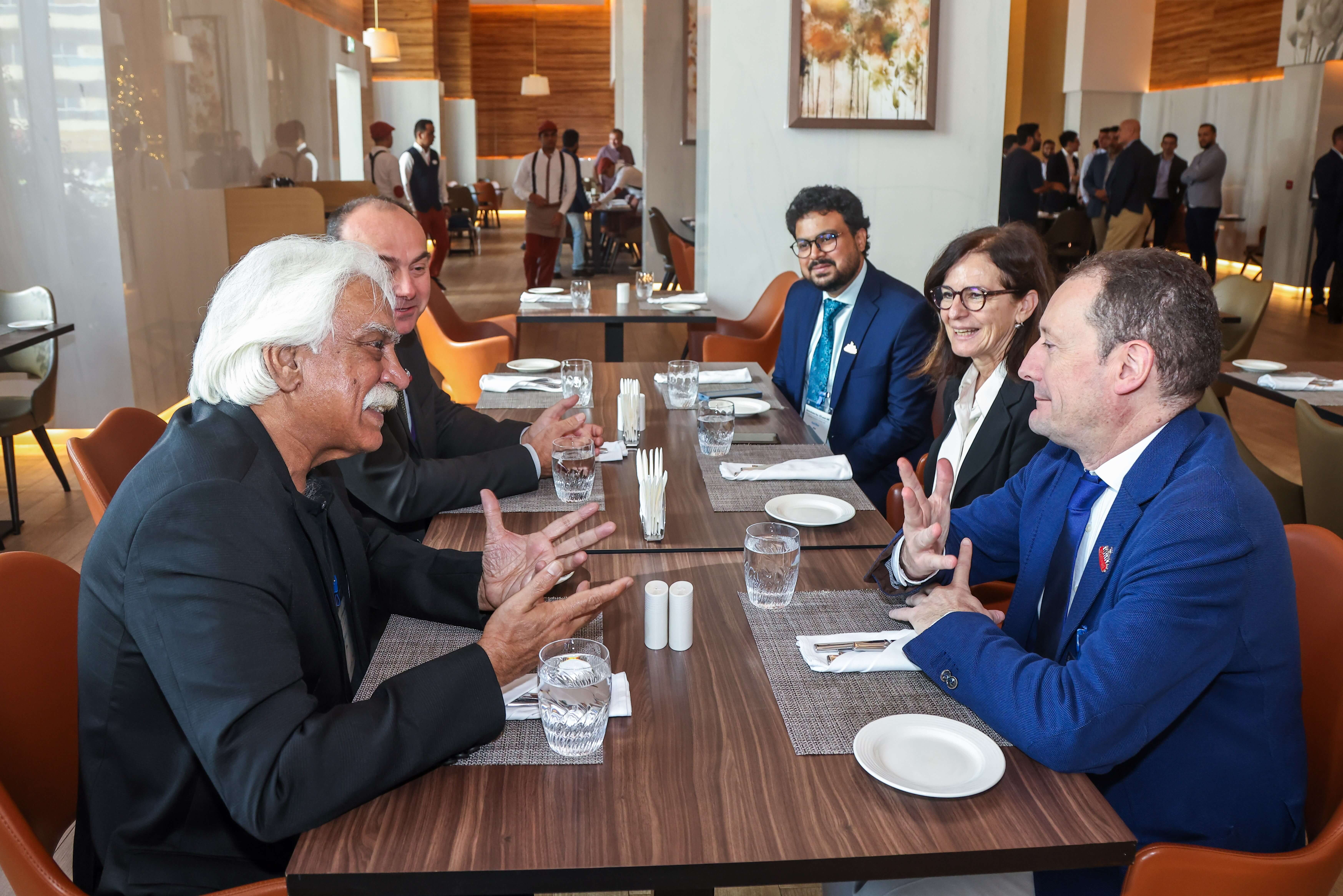
From left to right: xFlow Research CEO Ashok Malani; ETSI CTI Director Laurent Velez; xFlow Research President Fazal-e-Rehman Khan; ETSI Technical Officer Chantal Bonardi; ETSI Director General Luis Jorge Romero
The UAE stands as one of the most technologically advanced nations; consistently pushing boundaries and embracing innovation to enhance the quality of life. This event aims to introduce ETSI to this region to raise awareness about ETSI’s standards, their standardization activities and provide an opportunity for the UAE stakeholders to come together, collaborate and explore avenues for future synergies.
In his welcome note, Fazal-e-Rehman Khan, President, xFlow Research, expressed that with wise leadership, “the UAE has demonstrated a keen understanding of the transformative powers of technology in addressing global issues, fostering innovation and creating a positive impact on the lives of the people.”
As part of the event’s introduction, du representatives have shed the light on the UAE-based leading telco’s huge focus and support on standardization and enabling connectivity for economic, social and digital transformation. du touches the lives of millions every year and is an enabler of connectivity with continuing growth across consumers and enterprises. du has nationwide coverage and its network is declared as fully global, having access to 2G/3G/4G/5G standards, and working alongside ITU, GCF, GSMA, 3GPP, and now, ETSI. Moreover, du currently leads the technological innovation in the light spectrum, sustainability and international collaboration.
ETSI: The Home of ICT Standardization
Designing tomorrow’s world, ETSI is at the forefront of new ICT; leading the development of standards that enable a sustainable and securely-connected society. With over 30 years of track record in technical excellence, ETSI has an open and inclusive environment, having more than 900 member organizations globally.
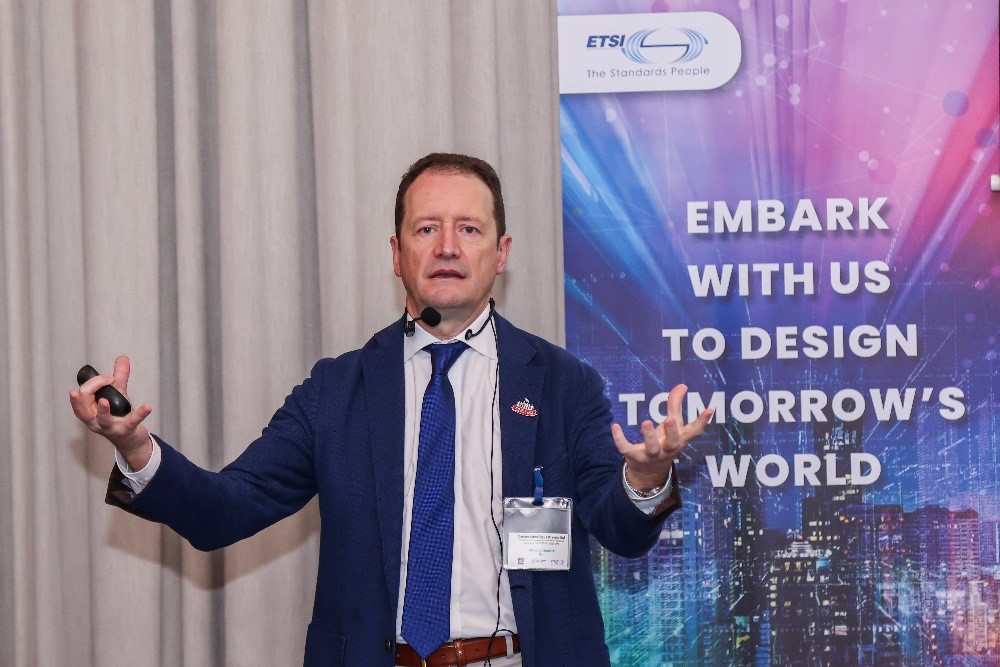
ETSI Director General Luis Jorge Romero
In his presentation, ETSI’s Director General, Luis Jorge Romero, showed how “things happen from the bottom up” in their organization. He emphasized three aspects of their structure: technical committees, industry specification groups (ISGs), and software development groups (SDGs).
Technical committees (TCs) are the starting point and consist of a group of experts handling different topics while ISGs are the pre-normative incubator for research and the perfect tool for pre-standardization work. Designed for collaborative software development, SDGs embody the essence of implementation and standardization. Both ETSI ISGs and SDGs are open to ETSI members and non-members.
All have actively supported and contributed to 3GPP, with ETSI aligning itself with 3GPP, the global standards organization for mobile communication. “We want to do many things, and this is possible as all our members come together to push for ICT standardization. We strive for partnerships in areas out of our expertise and address geographical issues.”
ETSI Technical Officer, Chantal Bonardi, took a deep dive into five technical standardization domains that ETSI and 3GPP are working on: Intelligent Transport Systems (ITS), Augmented Reality, Smart Body Area Network (SmartBAN), Lawful Interception (LI) and Retained Data (RD), and Emergency Communications (EMTEL).
On the other hand, the ETSI Centre for Testing & Interoperability (CTI) Director, Laurent Velez, focused on IoT standardization and one of their partnership projects: oneM2M. Calling it the ‘glue to connect,’ this horizontal IoT platform streamlines the onboarding of new applications and devices. Due to its distributive and scalable nature, it is useful for developers, interoperable with other standards and has flexible deployment options.
Giving more context to the data, Velez also mentioned the importance of the ETSI TC SmartM2M. The SAREF (Smart Applications REFerence) allows connected devices to exchange semantic information in many IoT applications’ domains.
2030: Decade for 6G
While there is no unanimous definition of 6G, it is anticipated to be a blend of incremental technological advancements from 5G and the introduction of some revolutionary new concepts. With a new generation coming every 10 years, the first 6G services are anticipated to be deployed in 2030.
ETSI’s Director General, Romero, mentioned that there are “many pieces of the puzzle which serve as building blocks in 6G and ETSI helps in standardizing them.” This window of opportunity will be successful by “staying together, embracing differences, and contributing to influence.”
Conversations regarding the 6G work plan are currently in progress, focusing on the research and vision phase. More formal standards for 6G will follow later and are expected to begin in 3GPP in Rel-20 (6G initial studies) and Rel-21 (6G service requirements).
Fragmentation Risk and Standardization Benefits
ETSI’s Director General believes that “Equanimity is essential to preserve the cornerstones of standardization,” especially within the current (and future) geopolitical situations. ETSI and 3GPP adopt a neutral position, treating all members equally to maintain a single global standard approach (moving from 5G to 6G).
Bonardi noted that standardized solutions are a win-win situation that ensure “quality, efficiency, security and interoperability.” ETSI standards are open to avoid vendor lock-in and are developed through collaboration, for the benefit of all: users, investors, manufacturers and regulators.
MEC in Action
Another important aspect tackled is ETSI’s ISG on Multi-Access Edge Computing (MEC). Dario Sabella, Chairman, ETSI ISG MEC, noted that “contribution is important.” At ETSI MEC, they believe in a contribution-driven, access-agnostic standardization approach, with API as their core business. “The future is written by you,” added Sabella. In facilitating global app portability, ETSI is unable to publish all APIs but strongly encourages the use of compliant APIs.
During the ETSI-UAE Standardization Day, which targets paving the way towards deeper cooperation between ETSI and the UAE telecom industry, Sabella announced that du is the first operator in MENA that has joined the MEC ISG, confirming its role at the MENA Standardization forefront.
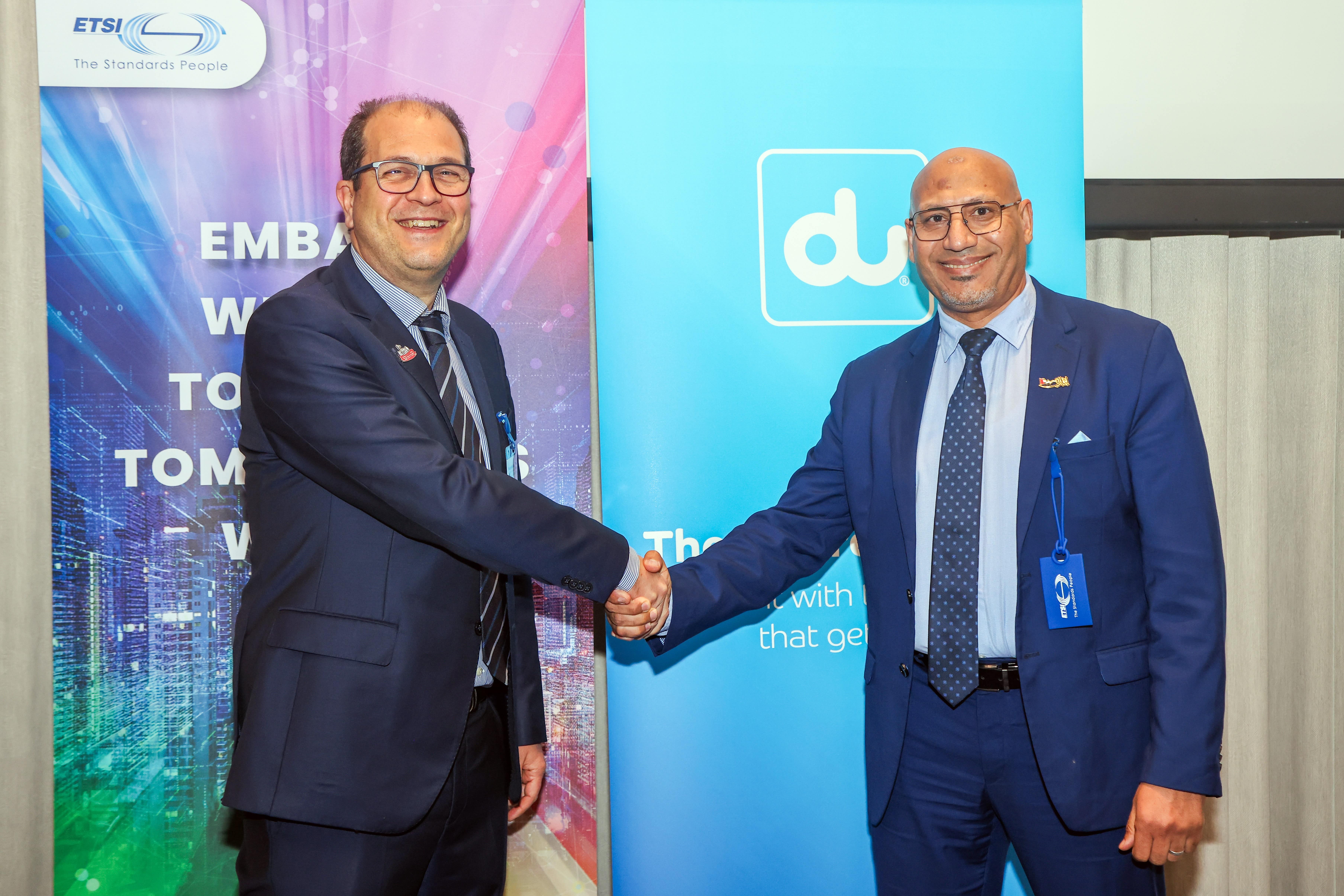
From left to right: Dario Sabella, Chairman, ETSI ISG MEC and Fathi Abdeldayem, Technology Standardization, R&D and Evolving Technologies, du
This announcement confirms the vision of the management regarding 5G and 6G, with MEC providing a new ecosystem and value chain. Operators can open their Radio Access Network (RAN) edge to authorized third parties, allowing them to flexibly and rapidly deploy innovative applications and services to mobile subscribers, enterprises and vertical segments.
ETSI MEC provides application developers and content providers with cloud computing capabilities and an IT service environment at the network edge. This facilitates advancements in various sectors, including automotive, industrial automation, VR/AR, and smart cities.
The MEC Standard has advanced from Phase 1 to Phase 3, and the transition to MEC Phase 4 is poised to bring about more consolidated efforts on MEC Federation. This involves addressing multi-domain and multi-tenancy slicing, MEC support for application slicing, and the introduction of normative work to enhance security and privacy in MEC systems.
Technology Talks and Demo Booths
At the event, the introduction of the technology talks and demo booths proved to be a triumph. Positioned strategically, these talks and booths allowed valued industrial partners, Technology Innovation Institute (TII), Canonical, Keysight, Rakurai.io, DYA.ai, and Rhode and Schwarz to present and demonstrate their latest products and services built in line with the ETSI standards. Attendees seized the opportunity to engage with industry professionals, experience live demos, and delve into insightful discussions about the future roadmap of telecommunications.
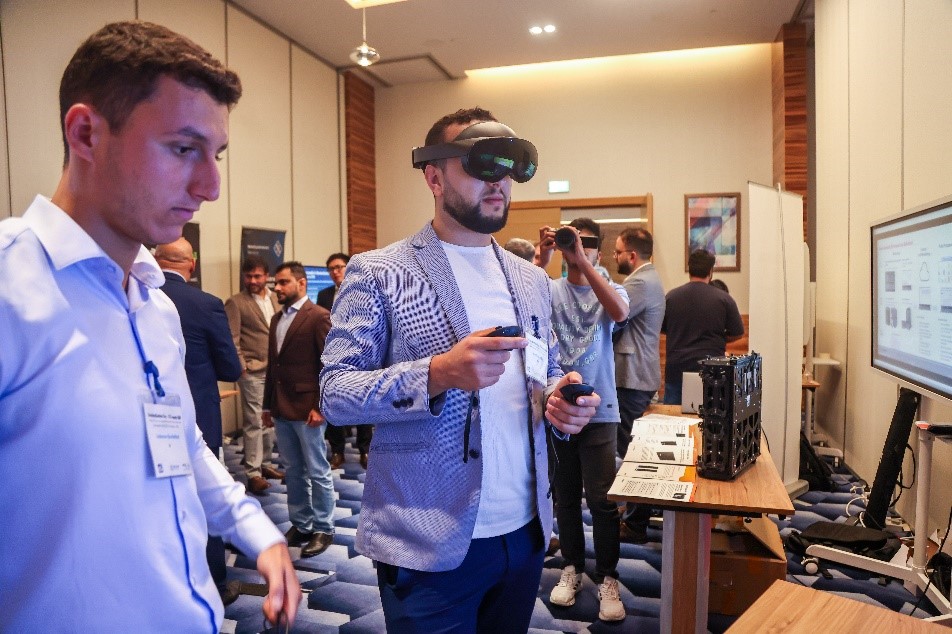
Live Demo During the ‘Standardization Day - ETSI Meets UAE’ Event




